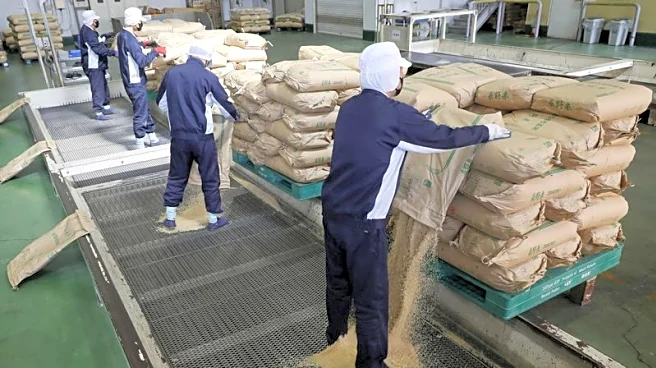What's Happening?
Japan's agriculture ministry announced that the country's calorie-based food self-sufficiency rate remained at 38% for fiscal year 2024, marking the fourth consecutive year without change. Despite increases in domestic production of rice, sugar beets, and sugarcane, adverse weather conditions such as downpours and droughts in southwestern and western regions led to decreased wheat and soybean output. The self-sufficiency rate is significantly below the fiscal 2030 target of 45%, set by Prime Minister Shigeru Ishiba's cabinet in April. The ministry also reported a calorie intake-based self-sufficiency rate of 46%, focusing on calories consumed for daily living.
Why It's Important?
The stagnation in Japan's food self-sufficiency rate highlights ongoing challenges in achieving greater domestic food production. This issue is critical for Japan's food security and economic stability, as reliance on imports can make the country vulnerable to global market fluctuations and trade tensions. Increasing self-sufficiency is essential for reducing dependency on foreign food sources and ensuring stable food supply chains. The government's target of 45% by 2030 underscores the need for strategic initiatives to boost agricultural productivity and resilience against climate-related disruptions.
What's Next?
To address the stagnant self-sufficiency rate, Japan may need to implement policies that enhance agricultural productivity and expand domestic production. This could involve investing in technology and infrastructure to mitigate the impacts of adverse weather conditions. Stakeholders, including policymakers and agricultural producers, are likely to focus on strategies to meet the 2030 target, potentially leading to reforms in agricultural practices and increased support for local farmers.
Beyond the Headlines
The issue of food self-sufficiency in Japan also raises ethical and environmental considerations. Efforts to increase domestic production must balance sustainability with economic goals, ensuring that agricultural practices do not compromise environmental health. Additionally, cultural shifts in dietary preferences and consumption patterns may influence future strategies for achieving higher self-sufficiency rates.












